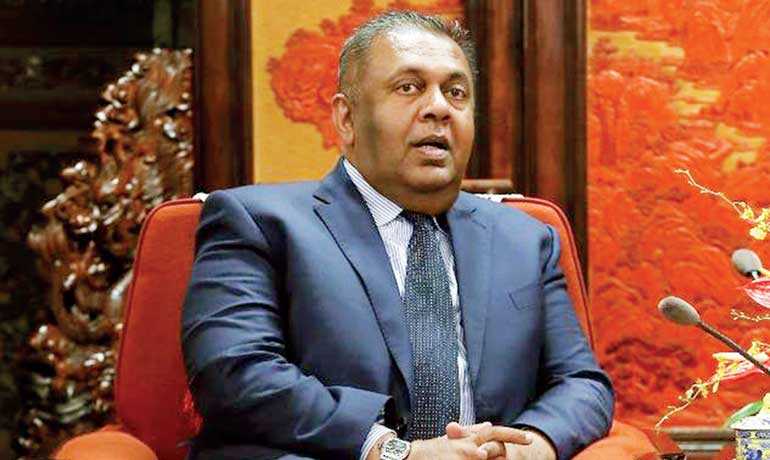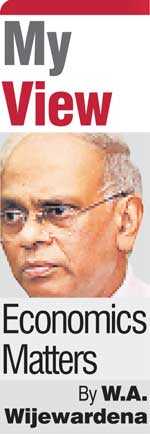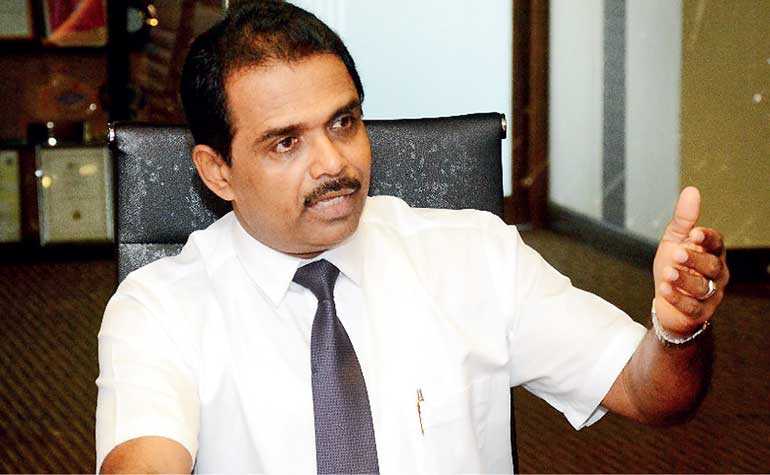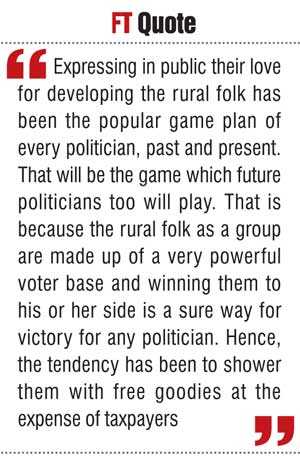Tuesday Apr 08, 2025
Tuesday Apr 08, 2025
Monday, 21 May 2018 00:10 - - {{hitsCtrl.values.hits}}

Minister Mangala Samaraweera
Gam Peraliya to the rescue
Finance Minister Mangala Samaraweera, announcing the Government’s decision to move for a flexible fuel price system based on international prices built into a  pricing formula, made a side announcement as well.
pricing formula, made a side announcement as well.
That was to give back the entirety of the money saved from the adjustment of fuel prices to reflect their costs amounting to about Rs. 56 billion in this year to a new development programme titled ‘Gam Peraliya’ (available at: http://www.island.lk/index.php?page_cat=article-details&page=article-details&code_title=184435 ).
This catchy title has been borrowed by him from the classic novel Gam Peraliya by Sri Lanka’s iconic writer, Martin Wickramasinghe. In this novel, Wickramasinghe had fictionalised the transition of power in a Southern village in colonial Sri Lanka from the traditionally rich to the newly rich. Going by the vision of Mangala’s project, there could not be a more appropriate title to it.
Creation of a rural entrepreneurial class
Critics were quick to point out that Mangala had tried to lessen the feeling of burden falling on people due to fuel price hike. There is an element of truth in this criticism because that occasion would not have been the best for him to make the announcement about the proposed new village development scheme.
However, in his budget as well as his closing speech at the Budget debate, he had made reference to numerous schemes to develop the rural-based economy of Sri Lanka, though the tagline Gam Peraliya had not been used at that time.
His philosophy of development of the rural folk, especially the rural youth, was cogently pronounced in his response in the final budget day as follows: “We envisage the day when the farmer’s daughter becomes an agribiz-entrepreneur, when the fisherman’s son becomes a seafood exporter. Sri Lanka needs to go back to its roots of being a nation of entrepreneurs, a nation of traders. To do this we must be open to global trade, embrace competition, and take on the world and win.”
Empowering the rural folk to stand on their own feet
Thus, his objective has been to link villages to the wider global economy as partners of the global production sharing system that is ruling the global economy today. Thus, his vision is not to pump money into villages as subsidies as had been done by Sri Lanka for long. He plans to increase the capacity of villages as viable production units so that, as he has claimed, they would be able to decide on their own destiny.
This is in line with the pronouncement by the 6th century BCE Chinese philosopher Confucius. When he was returning from a fishing expedition, a beggar sitting by the road had asked him for a fish. Confucius is said to have told him: “I will not give a fish to you, but teach you how to catch a fish”. A similar wisdom was pronounced by Chanakya, also known as Kautilya of The Arthashastra fame, in the Ethics of Chanakya in 4th century BCE. Said Chanakya, “It is enterprise and not charity that causes poverty to vanish”.
This vision at first sight appears to be a brutal one. But, it helps the poor people to stand on their own feet and become responsible members of society. If this can be achieved, it would really be true ‘Gam Peraliya’ repeating itself in a new cycle of converting villages into entrepreneurial hubs.

Nihal Ranasinghe
Showering the poor with free goodies
Expressing in public their love for developing the rural folk has been the popular game plan of every politician, past and present. That will be the game which future politicians too will play. That is because the rural folk as a group are made up of a very powerful voter base and winning them to his or her side is a sure way for victory for any politician. Hence, the tendency has been to shower them with free goodies at the expense of taxpayers.
In Sri Lanka’s case, since the government gets its revenue principally via indirect taxes levied on mass consumption goods, it is mainly the rural folk that contribute to fill the government coffers as well. Hence, in effect, it is the rural folk themselves who pay for such free goodies. Yet, since they are driven to a temporary myopia, they fall for such promises and help politicians to bind them to a never ending cycle of poverty, deprivation and destitution.
But, Mangala’s promise has been different. He suggests empowering the rural folk economically so that they would be able to stand on their feet and manage their affairs by themselves without depending on outside free goodies. Economists call this ‘weaning the rural folk away from dependency syndrome’.
Central Bank’s Isuru Project
This writer has the first hand experience in running a dozen odd rural development projects when he was in the Central Bank.
One such project was the Small Farmers’ and the Landless Credit Project, dubbed in Sinhala ‘Isuru Project’, first implemented as a pilot project in four selected districts but later extended to the whole island. The objective of the project was to help the rural poor to cross the poverty line by empowering them financially and entrepreneurially. The theme vision of the project was same as the diction of Confucius and Chanakya in ancient times: the project will help you empower yourself so that you can stand on your own feet and work hard toward your own economic liberation.

The modus operandi adopted was the following. The poor were organised into self-help groups of five to 10 members. Thrift and savings were inculcated in them right from the very beginning because anyone who does not know how to save would not be able to handle the money given to him by another. The requirement was for each member to save just Rs 5 a week and deposit into a group account with the Regional Development Bank of the district concerned, the banker to the project.
A six- to 12-month social mobilisation program was carried at the expense of the project. In that program, they were given ideological wisdom as to why they were poor and how they could come out of poverty.
In addition, they were trained in the art of conducting group meetings and working as a team. Then, they were given technical know-how in the fields of comprehensive farming, livestock development, handicraft, selling, etc. Then, they were ready to get a bank loan because in the terminology of bankers, they were now ‘bankable customers’.
Mutual or inter se guarantees
The guarantees for the loans were given by other members of the group in what is known in microfinance as ‘mutual guarantees’ or ‘inter se guarantees’. Thus, the loan supervision was made the responsibility of the group which was more effective than the supervision done by bank managers who relied on the remote mode rather than onsite sight of the borrowers.
Loans were given to them first in small amounts and later when they repaid the old loan, new loans of higher amounts were granted. This is known in microfinance as a graduated scale of lending. The essential feature of the project was that loans were given at slightly above the market rates rather than at subsidised rates. That was to keep the well-to-do in the villages away from the loan scheme.
Poverty alleviation is not a rosy path
This approach to poverty alleviation is not easy and without hiccups. A large number of governmental and non-governmental organisations teamed up with the Central Bank to make the project a success. Among the governmental agencies, a prominent role was played by the Industrial Development Board, Department of Agriculture and the Department of Livestock Development. The prominent non-governmental players were Sanasa, Sarvodaya and World Vision.
It was not an easy path to prosperity. Many members who joined the project got themselves dropped out in the midstream and special strategies had to be employed to get them back to the project. According to an impact assessment survey conducted by the donors of the project, namely the International Fund for Agricultural Development or IFAD and the Canadian International Development Agency or CIDA, in 1997 it was revealed that 80% of the original beneficiaries had succeeded in crossing the poverty line in about five to seven years.
A subsequent impact assessment survey conducted by the Regional Development Department of the Central Bank in 2005 has put this number to 63% where the participants have agreed that they were able to cross the poverty line through the support given by the project. What it means is that there is no possibility to maintain a hundred percent success rate in poverty alleviation projects. The success rate is always below that ideal. Even then, that success rate begins to shrink as time passes due to their inability to cope with new adverse developments.
Village level statistical base a must
Thus, Mangala’s Gam Peraliya will remain only wishful thinking unless he is able to establish an effective machinery to convert it to concrete action. One problem he faces in this respect is the absence of a reliable data base for providing the support to villages and effectively monitoring their progress.
For this, a comprehensive village level data base has to be assembled, regularly updated and used at the centre for progress monitoring. Without this, Mangala will simply pump money to a project where he would not know even where the moneys have gone.
National Operations Room
The importance of timely availability of data had been felt even in the past when it came to implementing development projects. To address this issue, in 1989, the Governor of the Central Bank, Dr. H.N.S. Karunatilake, established a National Operations Room in the Central Bank. All the socio-economic data relating to Sri Lanka’s regions and the centre were collected, digitised and made available for the purpose. However, this operations room was transferred to the Ministry of Plan Implementation later and there, it is reported to have met with a natural death. If there is a genuine interest in undertaking a development initiative in the country, it is necessary to resuscitate similar machinery within the government.
Nihal Ranasinghe’s personal initiative
A senior public servant, Nihal Ranasinghe, presently the Controller General of Immigration, has developed a comprehensive data base for all the villages in Sri Lanka titled Extended Rural Development Monitoring System or ERDMS. This exercise he has completed on his own because of his personal interest in development administration. He had been an administrative service officer in the regions for a number of years and during that period, he had experienced the necessity for reliable socio-economic data at the village level in order to implement development work there.
This interest was further strengthened when he took courses in development economics and development administration for his MPA degree at the Postgraduate Institute of Management.
Nihal: Reliable data are a must
On inquiry, he revealed to me why he used his free time to develop this data base. “Without data, those of us who plan and implement village level development schemes have to grope in the dark. The conditions in villages are different from each other. Hence, it is wrong to work on the assumption that they are all in a similar situation. Some villages have the problem of water. Some have the problem of roads. Some other villages are faced with the problem of marketing their agricultural produce. Some don’t get bank financing in time. All this information has to be gathered and made available to planners as well as plan implementation agencies to enable them to address the issues at hand in each village. I have gathered data for 32,000 villages and they are all available in a single computer data base. This can be used for developing appropriate strategies for handling village level issues.”
Mangala should tap this goldmine
This is indeed a goldmine to be tapped by Mangala in his initiative to support the development of a village level entrepreneurial class. Ranasinghe’s ERDMS can be used as the basic input when framing any national level development activity monitoring programme.
The data form has three parts and when information relating to province, administrative district, division, etc. is inputted, it autogenerates a unique identification number for each village. These numbers collected into a single compendium can be used, like a telephone directory, to refer to any particular village of choice. The other parts consist of demographic data and development data. Once projects are completed, they can be automatically updated to provide any centre-level supervision and monitoring. According to Nihal Ranasinghe, an additional advantage of his ERDMS is that any visiting Minister or senior public servant can arm himself with the profile facts of the village before he goes there. He is therefore in a better position to address the specific issues relating to that village.
These are real innovations done in the public service and Mangala may use them in order to effectively implement his development programmes.
(W.A. Wijewardena, a former Deputy Governor of the Central Bank of Sri Lanka, can be reached at [email protected]).
Discover Kapruka, the leading online shopping platform in Sri Lanka, where you can conveniently send Gifts and Flowers to your loved ones for any event including Valentine ’s Day. Explore a wide range of popular Shopping Categories on Kapruka, including Toys, Groceries, Electronics, Birthday Cakes, Fruits, Chocolates, Flower Bouquets, Clothing, Watches, Lingerie, Gift Sets and Jewellery. Also if you’re interested in selling with Kapruka, Partner Central by Kapruka is the best solution to start with. Moreover, through Kapruka Global Shop, you can also enjoy the convenience of purchasing products from renowned platforms like Amazon and eBay and have them delivered to Sri Lanka.
Discover Kapruka, the leading online shopping platform in Sri Lanka, where you can conveniently send Gifts and Flowers to your loved ones for any event including Valentine ’s Day. Explore a wide range of popular Shopping Categories on Kapruka, including Toys, Groceries, Electronics, Birthday Cakes, Fruits, Chocolates, Flower Bouquets, Clothing, Watches, Lingerie, Gift Sets and Jewellery. Also if you’re interested in selling with Kapruka, Partner Central by Kapruka is the best solution to start with. Moreover, through Kapruka Global Shop, you can also enjoy the convenience of purchasing products from renowned platforms like Amazon and eBay and have them delivered to Sri Lanka.